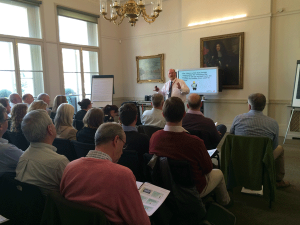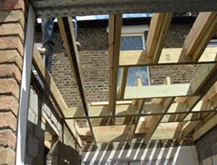 Working at Height and Slips, Trips and falls.
Working at Height and Slips, Trips and falls.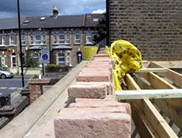
Yes I know that I have covered this before, but when I saw these pictures from the HSE who had visited a small domestic refurbishment site, I felt that it should be highlighted again. Their report said:
“Found on a small domestic refurbishment site involving an extension to the rear of a terraced house. These workers were laying bricks while standing on unprotected edges and open joists, with no means to prevent a fall. A prohibition notice was served to stop work at height immediately.”
This week’s 2 recent HSE cases look at problems with working at height.
- HSE’s message to smaller businesses is don’t wait for an accident or visit from an inspector before you make the change.
- If the company had managed a safe system of work with properly trained and equipped scaffolders, then the employee would not have suffered such terrible injuries
As ever, if you have a subject that you would like us to cover one week, please contact us by phone 01458 253682, email or via our Facebook page or by Twitter.
Working at Height and Slips, Trips and falls.
Slips, trips and falls from height can all have serious consequences. Everyone can do more to ensure that their workplace becomes a safer environment. The effects of slips, trips and falls at work are far reaching, both for those involved, their families and the industries they work in. The cost to society alone is in the order of £800 million per year.
The HSE have a program running at present on ‘Slips, trips and falls’
Work at Height Regulations 2005
The Work at Height Regulations 2005 came into force on 6 April 2005. The Regulations apply to all work at height where there is a risk of a fall liable to cause personal injury.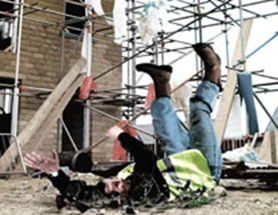
They place duties on employers, the self-employed, and any person that controls the work of others (for example facilities managers or building owners who may contract others to work at height).
As part of the Regulations, duty holders must ensure:
- all work at height is properly planned and organised;
- those involved in work at height are competent;
- the risks from work at height are assessed and appropriate work equipment is selected and used;
- the risks from fragile surfaces are properly controlled; and
- Equipment for work at height is properly inspected and maintained.
There is a simple hierarchy for managing and selecting equipment for work at height. Duty holders must:
- avoid work at height where they can;
- use work equipment or other measures to prevent falls where they cannot avoid working at height; and
- Where they cannot eliminate the risk of a fall, use work equipment or other measures to minimise the distance and consequences of a fall should one occur.
The Regulations include schedules giving requirements for existing places of work and means of access for work at height, collective fall prevention (e.g. guardrails and working platforms), collective fall arrest (e.g. nets, airbags etc.), personal fall protection (e.g. work restraints, fall arrest and rope access) and ladders.
Key messages to duty holders are:
Those following good practice for work at height now should already be doing enough to comply with the Work at Height Regulations;
- Follow the risk assessments you have carried out for work at height activities and make sure all work at height is planned, organised and carried out by competent persons;
- Follow the hierarchy for managing risks from work at height – take steps to avoid, prevent or reduce risks; and
- Choose the right work equipment and select collective measures to prevent falls (such as guardrails and working platforms) before other measures which may only mitigate the distance and consequences of a fall (such as nets or airbags) or which may only provide personal protection from a fall.
The Work at Height (Amendment) Regulations 2007 which came into force on 6 April 2007 apply to those who work at height providing instruction or leadership to one or more people engaged in caving or climbing by way of sport, recreation, team building or similar activities in Great Britain.
Ok so you don’t work in construction but perhaps you work in:
Health and Social Care
Here there are the risks of things such as, for example, wet and slippery floors.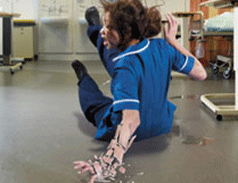
After monitoring health and safety records, bosses for one NHS Trust recognised they had problems with slips and trips on wet hospital floors.
Between 2002-2004 the Trust had to tackle in the region of 100 slips and trips from staff, all of which could be blamed on floors left wet after cleaning.
The Trust’s safety adviser attended a slips, trips and falls workshop which reinforced the belief that more could and should be done. This prompted the Trust to look again at the areas where falls were occurring to identify trends. Around the same time the Trust was unfortunate enough to have a member of staff fall in a ward area after the floor had been mopped.
An inspector from the Health and Safety Executive recommended that changing the way mopping was done could reduce the risk of slips and trips. He suggested using a dry mopping system using micro fibre, would limit the amount of fluid on the floor.
Micro fibre mops are designed to pick up dirt and cling to it. Rather than saturating the mops, the mops are placed into a bucket and left to soak up the water and cleaning fluid. This reduces the amount of residue that is left on the floor during and after mopping. The staff were also advised to mop and dry the floor in sections before moving onto the next part of the ward, to provide safe access around the area.
The Trust’s safety advisor said: “At first the housekeeping staff were reluctant to change to a system that they believed would take much longer. However, once we started to see a decrease in the number of people slipping and how easy it was to implement, they were more than happy with the new way of working.”
The Trust purchased 11 systems and trialled them for four weeks. The results were so dramatic they bought another six so they could roll the method out across all wards.
Since the Trust implemented the system in has had an 85% reduction in falls from the 100 reported in the previous two years.
An office environment
“Well I work in a nice safe office environment and there’s no risk of falling here is there?”
Sadly there are too many slips, trips and falls in the office, all of which are avoidable. Have a look around your office and check:
- How good is the flooring? Are there damaged or worn areas of carpet? These often get overlooked or not given a high priority until somebody trips and seriously injures themselves.
- Cables across floors are another common occurrence in offices, especially if the building wasn’t originally designed as an office. Or it was first used as an office before the introduction of so many electrical items and so extension leads are required.
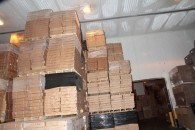
- Are there boxes of old files etc. stacked on top of high shelves that occasionally need to be accessed?
- And, when they are required, is there a pair of stepladders available to get them down or do you just quickly use an office chair?
- Do you walk up or down the stairs with your hands and arms full of books and files? Slips and trips on stairs are a common cause of injuries at work, but there is no mandatory requirement to “hold the handrails”. However “common sense” would recommend that you at least keep one hand available to grab the handrail should you trip, slip or lose your balance.
Using ladders or stepladders
Ladders and stepladders are used by people in all sorts of business and some people have asked if they are now banned under Health & Safety Law. Well the answer is No they are not banned and can be used if they are the most appropriate means of access for the job in hand. However there are some sensible tips for using a ladder safely and these are listed below. The ladder should be:
- Prevented from slipping,
- Prevented from moving before it is stepped on,
- Long enough to do the job safely,
- Have a handhold available to allow the worker to maintain 3 points of contact where possible,
- Used without overreaching,
- Inspected and checked regularly where necessary.
Duty holders should check that workers are fit to use the equipment that they are provided with. Employees or contractors should report any issues (including health issues) that may affect their safety or the safety of others. Some of the human factors that would prevent you from using a ladder are:
- Recurring dizziness
- Epilepsy
- Psychiatric conditions (Including fear of heights)
- Heart condition
- Severe lung conditions
- Alcohol and drug abuse
- Significant impaired joint function
- Medication that recommends you do not operate machinery could also be a problem
So regardless of what industry you are employed in, the risk of slips, trips or falls should be high on your list of risks to assess and prevent. Unlike the roofer in the first of this week’s HSE cases!
If you need further information please call us on 01458 253682 or send us an email.
Training Courses
We have no more open courses organised for this year but shall be running new courses again in 2016.
But remember we are still available for running “In House” courses and we have two of these organised in December covering Asbestos and CDM2015.
If you have any questions about these courses or any other training or would like us to run a particular course for you, call Jon Wilkins of the Wilkins Safety Group on 01458 253682 or email him.
Your business is safer in our hands

